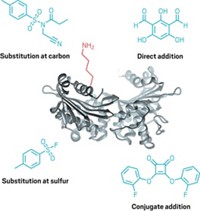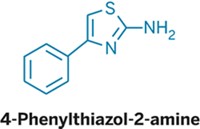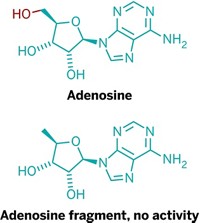Advertisement
Grab your lab coat. Let's get started
Welcome!
Welcome!
Create an account below to get 6 C&EN articles per month, receive newsletters and more - all free.
It seems this is your first time logging in online. Please enter the following information to continue.
As an ACS member you automatically get access to this site. All we need is few more details to create your reading experience.
Not you? Sign in with a different account.
Not you? Sign in with a different account.
ERROR 1
ERROR 1
ERROR 2
ERROR 2
ERROR 2
ERROR 2
ERROR 2
Password and Confirm password must match.
If you have an ACS member number, please enter it here so we can link this account to your membership. (optional)
ERROR 2
ACS values your privacy. By submitting your information, you are gaining access to C&EN and subscribing to our weekly newsletter. We use the information you provide to make your reading experience better, and we will never sell your data to third party members.
Pharmaceuticals
Chemists Increasingly Consider Residence Time In Drug Design
Drug Discovery: Studies suggest duration of binding, not just affinity, may be a key factor
by Stu Borman
June 22, 2015
| A version of this story appeared in
Volume 93, Issue 25

In drug discovery, researchers think a lot about how tightly a small molecule binds to its target. For a long time, drug developers have considered tightly binding compounds better, more promising drug candidates than molecules that interact weakly with their targets. So improving binding affinities is a critical aspect of medicinal chemistry and drug design.
Recently, an alternative parameter called residence time—how long a drug remains bound to its target—has been attracting growing interest. Although it isn’t as well recognized or as widely used as binding affinity, some researchers think residence time may represent an equally important parameter to consider for predicting compounds’ therapeutic potential and optimizing their properties. In fact, studies have shown that highly potent marketed drugs remain on their targets longer than those with lower efficacy.
But limited understanding of the way different properties of drugs and targets affect residence times and a lack of systematic approaches for identifying drugs with long residence times have discouraged broader use of the concept. Now, two studies provide tools and data that could help advance residence time toward greater acceptance.
In one, Peter J. Tonge of Stony Brook University, SUNY; Stewart L. Fisher of AstraZeneca R&D, in Waltham, Mass.; and coworkers report a new mathematical model for using residence time to predict the efficacy of antibiotics in cellular assays and in animal tests (Nat. Chem. Biol. 2015, DOI: 10.1038/nchembio.1796). Generally, the model predicts that a molecule’s effectiveness increases linearly with residence time.
In particular, the team looked at a phenomenon called the post-antibiotic effect. Some antibiotics remain effective after little to no free drug is left in the bloodstream. This is likely because of persistent binding of the drug to its target in cells. Researchers have struggled to predict this prolonged efficacy response. Tonge, Fisher, and coworkers used residence time and other parameters in their model to predict post-antibiotic effects for a series of enzyme inhibitors. The predictions matched up well with previous experimental data on some of the inhibitors.
The approach could aid the development of new antibiotics “because it gives you an in vitro way of predicting which drugs are going to give you a good post-antibiotic effect and which will not,” says Robert A. Copeland, president of research and chief scientific officer of Epizyme, in Cambridge, Mass., who pioneered the residence time concept about a decade ago.
The study shows that binding kinetics in general and residence time, which is a key component of binding kinetics, have “a hidden but pervasive role that can no longer be overlooked,” notes Rumin Zhang of Merck Research Laboratories, in Kenilworth, N.J., in a commentary published in Nature Chemical Biology.
“It is a nice paper with some elegant analyses,” says Piet H. van der Graaf, director of research and chair of pharmacology at Leiden University, in the Netherlands, but using a residence time model to predict efficacy is not “a particularly novel idea.” A number of residence time models have been reported since the 1960s, and developers of biologic agents already often consider binding kinetics and residence time in drug design, he says.
Copeland calls the new model a welcome addition to the existing ones and notes that its applications go beyond developing antibiotics. “It could also be applied to a broad range of pharmacological targets in cancer, inflammatory disease, and other conditions where you want to have a drug effect that lasts for a significant period of time,” he says.
Indeed, Tonge says he and Fisher have started a company called Chronus Pharmaceuticals, in Setauket, N.Y., to do just that.
In the second study, J. Michael Bradshaw of Principia Biopharma, in South San Francisco; Jack Taunton of the University of California, San Francisco; and coworkers show experimentally how residence times of a set of related compounds can be customized to vary from minutes to days (Nat. Chem. Biol. 2015, DOI: 10.1038/nchembio.1817).
They studied analogs of ibrutinib, an approved cancer drug, which works by forming an irreversible covalent bond between its acrylamide group and a cysteine residue in an enzyme called Bruton’s tyrosine kinase. Irreversibility gives the drug a long residence time: forever. But Bradshaw, Taunton, and coworkers thought reversible inhibitors could have fewer, less severe side effects than drugs such as ibrutinib because they would not form irreversible adducts with off-target proteins.
So the researchers designed new inhibitors in which a cyanoacrylamide replaces acrylamide. The cyanoacrylamide reacts with the same cysteine in the same enzyme to yield covalent bonds that are reversible, instead of irreversible. The researchers then modified the compounds’ structures to adjust the degree of reversibility and thus vary the inhibitors’ residence times from a few minutes to seven days.
They believe such inhibitors could be useful for treating inflammatory and autoimmune diseases, and Principia Biopharma currently has a reversible covalent inhibitor called PRN1008 in clinical trials.
The study’s approach for modifying residence times “worked exceedingly well,” Copeland notes in a published commentary. “These results clearly demonstrate the feasibility of developing general approaches to tuning the residence time of compounds” to match the biological requirements of specific targets, he says. For example, shorter residence times could be designed into drugs when long-lasting interactions with their targets cause toxicity. And longer residence times would be appropriate when less frequent administration of a drug, compared with agents exhibiting shorter residence times, might be advantageous.
Despite the results from these studies, “it is still early times” for the residence time concept, says Amaury Ernesto Fernández-Montalván, head of a high-throughput screening group at Bayer Pharma, in Berlin, who develops assays to measure residence time. “There is still discussion in this field about whether residence time is a meaningful parameter or not.” At Bayer, at least, “medicinal chemists are starting to get interested in this parameter and are asking for data on it,” he adds.





Join the conversation
Contact the reporter
Submit a Letter to the Editor for publication
Engage with us on Twitter